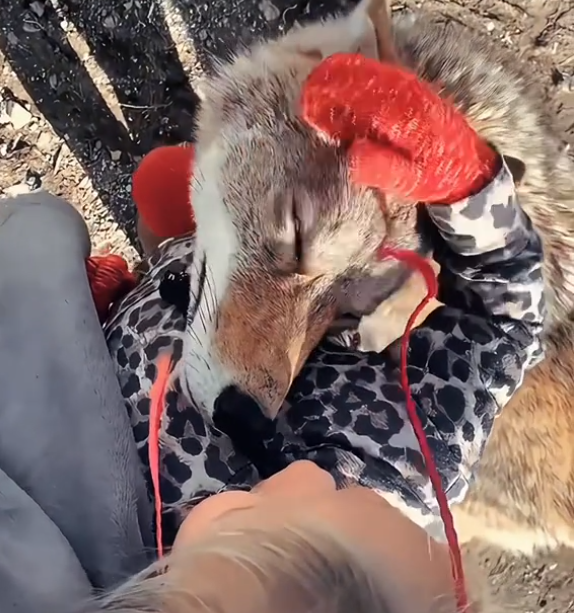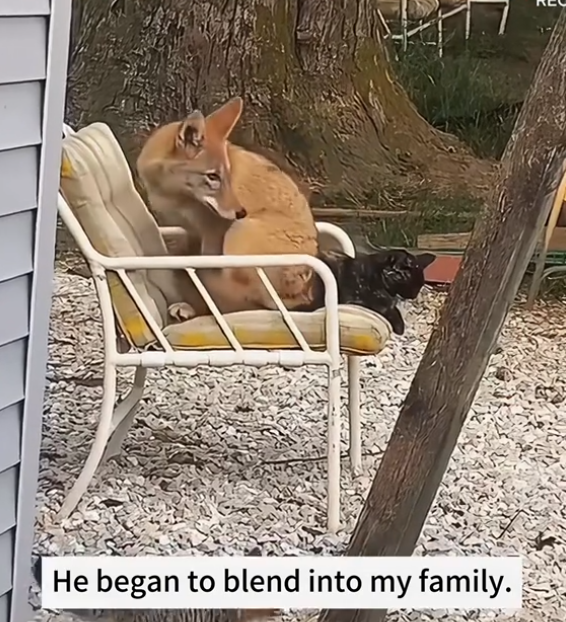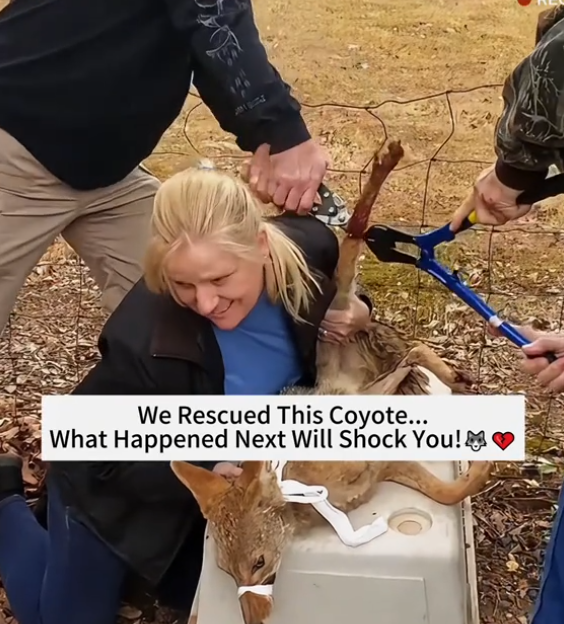
It all started on a chilly autumn morning just outside our small homestead near the edge of a pine forest. My younger brother, Evan, and I were heading out to check on our fence line when we noticed something strange near the edge of the tree line—a lump of fur that seemed too large to be a rabbit and too still to be a fox. Cautiously, we approached.
What we found was something we hadn’t expected: a young coyote, barely moving, breathing in shallow rasps. Its fur was matted, its ribs visible, and its eyes half-closed from exhaustion. At first, we thought it might be dead. But then its ear twitched.
“What do we do?” Evan asked, his voice hushed.
“Call Dad,” I whispered, and within minutes, our father came over with gloves, a blanket, and his first aid kit.
Coyotes are wild animals—intelligent, cautious, and notoriously hard to approach. But this one, either too weak or too resigned, didn’t resist as Dad gently wrapped it in a blanket and carried it to the back of the truck.
Back at the house, we made a makeshift enclosure in our barn. The coyote—who we began calling Dusty, for the greyish-brown color of his fur—drank the water we offered and slowly nibbled at pieces of cooked chicken. He didn’t growl or snap, but there was wariness in his eyes. We knew we were taking a risk. But the thought of leaving him to die out there felt worse.
The local wildlife rescue center was a good hour away, and they were already overwhelmed. When we called, they said they couldn’t send anyone for a few days. So, we took on the responsibility ourselves.
Over the next few days, Dusty gained strength. His posture became more alert, his movements more fluid. But instead of fleeing from us, he stayed in the enclosure, watching us with quiet curiosity. It was tempting to think he was beginning to trust us.
“I think he’s tameable,” Evan said one evening, watching Dusty lick broth from a bowl just a few feet away from us.

“Maybe,” I replied. “But that’s not the same as being tame.”
Our father reminded us daily: “He’s a wild animal. We’re helping him, not turning him into a pet.”
Still, we couldn’t help ourselves. We started spending more time near the enclosure, sitting quietly, speaking softly, letting Dusty get used to our presence. We offered treats—bits of cooked meat or pieces of jerky. After about a week, Dusty would take food from our hands. That small connection felt like a miracle.
We built trust gradually. Evan even started playing low music from a speaker when we were around Dusty, hoping it would help him associate human sounds with peace, not danger. Dusty responded. He didn’t show fear—only deep interest.
One afternoon, while Evan was cleaning the enclosure, Dusty approached him, tail low but wagging slightly. That was the first time Evan touched his fur without a glove. It was soft, wiry, and warm. Dusty closed his eyes for a moment.
“I think he likes it,” Evan whispered.
By the third week, Dusty would follow us when we walked around the barn, keeping his distance but clearly not afraid. He began to bark softly, like a dog testing his voice, and once even let out a low howl at sunset. We both stood frozen, awed by the sound—haunting, ancient, and somehow beautiful.
We started wondering: Could Dusty live with us? Could a coyote ever really be domesticated?
We read everything we could find. Coyotes, it turns out, are not like dogs. Though they’re related, they remain wild at heart. Even those raised from pups by humans rarely become fully tame. They’re clever, solitary, and unpredictable. But every animal is different—and Dusty didn’t seem like a threat.
That winter, we built a larger pen for him, complete with a shelter, toys, and space to run. He’d run to the fence when he saw us, sometimes even jumping in excitement. Evan taught him a few simple commands—“come,” “stay,” and “sit”—using treats and repetition. Dusty was smart. Smarter than any dog we’d known.
Yet, we began noticing signs that Dusty was growing restless. He’d stare out toward the woods at night, ears perked, nose twitching at unseen scents. He’d pace when he heard distant howls from the wild. One night, he dug furiously at a corner of the pen, stopping only when we came out with food.

“I think he wants to go back,” I told Evan.
“I know,” he said quietly. “But I don’t want him to.”
We were at a crossroads. We loved Dusty, but was it love to keep him in a cage, no matter how big? Or was love letting him be what he truly was?
We contacted a wildlife rehabilitation expert who visited and assessed Dusty. After watching him for a day, she said something that stuck with me:
“He trusts you. That’s rare. But he’s not domesticated—he’s adapted. And adaptation isn’t the same as belonging.”
It broke our hearts, but we knew what we had to do.
On a misty spring morning, we opened the pen. Dusty stepped out cautiously. He looked back at us several times, as if unsure whether he was free or in trouble. Then he turned toward the forest and trotted off.
No dramatic goodbye, no tears—just the sound of leaves crunching beneath his paws.
Weeks passed. We kept hoping we’d see him again. We even left food out near the edge of the woods. Occasionally it disappeared, though we never knew whether it was Dusty or another animal. One night, we heard a distant howl—low, familiar, and beautiful.
“Do you think it was him?” Evan asked.
“I want to believe it was,” I replied.
Looking back, rescuing Dusty changed us. It taught us that compassion for wild things doesn’t always mean taming them. Sometimes, it means helping them heal—and letting them go.
He wasn’t a pet. He was a traveler who crossed our path for a moment in time. And for that brief moment, we shared something special—respect, care, and a touch of wild magic.



